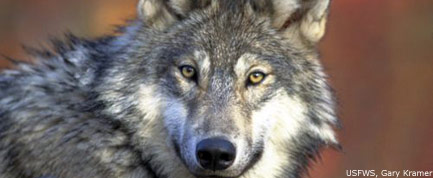Top Predators Key to Ecosystem Survival, Study Shows

Top-level predators strike fear in the hearts of the animals they stalk. But when a deer is being mauled by a wolf, at least it can know that it's giving its life for the greater good.
A new study reveals how ecosystems crumble without the presence of top predators be keeping populations of key species from growing too large. It also provides a cautionary lesson to humans, who often remove top predators from the food chain, setting off an eventual collapse.
The study is detailed in the July 20 issue of the journal Nature.
Food chain Whac-a-Mole
The researchers studied eight natural food webs, each with distinct energy channels, or food chains, leading from the bottom of the web to the top.
For example, the Cantabrian Sea shelf off the coast of Spain has two distinct energy channels. One starts with the phytoplankton in the water, which are eaten by zooplankton and fish, and so on up to what are called top consumer fish. The second channel starts with detritus that sinks to the sea floor, where it's consumed by crabs and bottom-dwelling fish, which are consumed by higher-up animals until the food energy reaches top-level consumers.
The top predators play their role by happily munching away at each channel's top consumers, explained study leader Neil Rooney of the University of Guelph in Canada.
Sign up for the Live Science daily newsletter now
Get the world’s most fascinating discoveries delivered straight to your inbox.
"Top predators are kind of like the regulators of the food web—they keep each energy channel in check," Rooney told LiveScience. "The top predator goes back and forth between the channels like a game of Whac-a-Mole," a popular arcade game in which constantly appearing moles are smacked down with a mallet.
Constant predation of the top consumers prevents a population from growing larger than the system can support.
Boom or bust
Removing a top predator can often alter the gentle balance of an entire ecosystem.
Here's an example of what can happen: When an area floods permanently and creates a series of islands, not all the islands have enough resources to support top predators. Top consumers are left to gobble up nutrients and experience a reproductive boom. The boom is felt throughout the system, though, as the booming species out-competes others, potentially driving the lesser species to extinction and reducing biodiversity.
Rooney refers to this type of ecosystem change as a "boom and bust cycle," when one species' population boom ultimately means another will bust. Bigger booms increased chances of a bust.
"With each bust, the population gets very close to zero, and its difficult getting back," he said.
Your role in all this
Humans often play a role in initiating boom and bust cycles by wiping out the top predator. For example, after gray wolves were hunted to near extinction in the United States, deer, elk, and other wolf-fearing forest critters had free reign and reproduced willy-nilly, gobbling up the vegetation that other consumers also relied on for food.
Or, more recently, researchers found that when fish stocks in the Atlantic Ocean are over fished, jellyfish populations boom. While jellyfish have few predators, removing the fish frees up an abundance of nutrients for the jellyfish to feast on.
Ecosystems provide us with the food we eat and help produce breathable air and clean water. But they're generally fragile and operate best when at a stable equilibrium, scientists say.
"These are our life support systems," Rooney said. "We're relying on them. This study points to the importance of top predators and that we need to be careful with how we deal with them."
- Top 10 Deadliest Animals
- Without Sharks, Food Chain Crumbles
- Image Gallery: Endangered and Threatened Wildlife
- Acid Buildup in Oceans Threatens Food Chain
- Here and Gone: The World's Biggest Beasts









